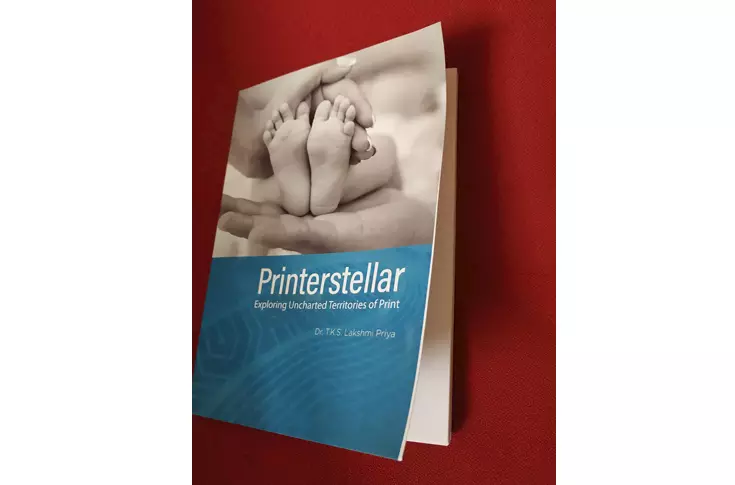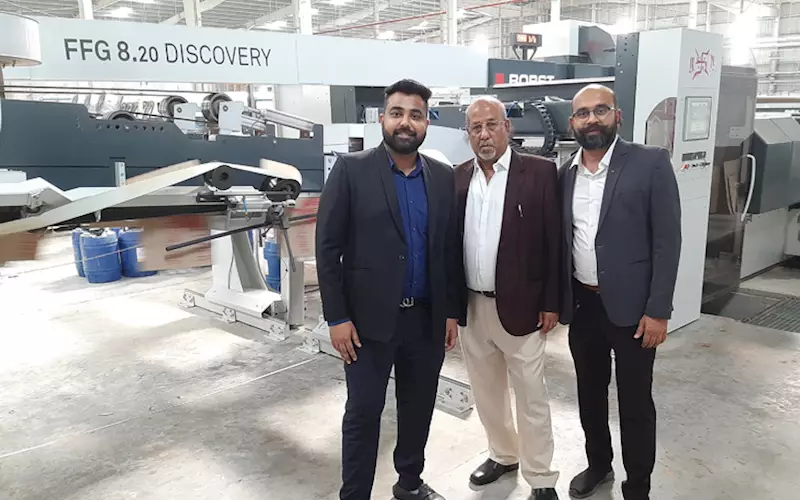Assam’s Krishna Board invests in Bobst FFG
Rampur, Assam based Krishna Board & Containers has recently installed a Bobst FFG 8.20 Discovery flexo folder-gluer. On purchasing the machine, Aditya Agarwal of Krishna Board & Containers said, “Quality has no price tag. Bobst offers one of the steadiest FFGs in the market. One can depend on the service and quality.”
08 Jul 2022 | By Rahul Kumar
He added, “It is definitely a huge investment, and one needs to calculate the financials cleverly before investing. Our reason for investing in Bobst was for the quality and speed that we can achieve in this machine.”
Krishna Board & Containers was established in 1983 in Dhubri, Assam. Gradually, the company grew from manual Ingle facets of 20-mpm to 300-mpm to fully automatic board lines, from screen printing of boxes to multi-colour printing facility. The company currently has two manual plants, two semi-automatic units and one fully automatic plant having a cumulative capacity of 7500-mt/ month.
Regarding the current trends in the corrugation industry, Agarwal said that the industry is going through a second revolution. “We saw the first revolution we saw around 2008 when people started upgrading from manual to semi-automatic plants. Right now, companies are upgrading the technology and speed from semi-automatic to fully-automatic plants. We are definitely seeing better technologies and better equipment in India,” he said.
He also believes that optimum utilisation of resources never shrinks a market, rather it opens up more opportunities and more windows. “High-end machines and optimum utilisation of paper will create the entry barrier between semi-automatic and fully-automatic plants in the coming years,” he added.
Krishna Board & Containers has been running the second fastest board line in India with 300-m/min since 1 November 2021. “The biggest challenge is the mindset, not the equipment. One needs to be mentally prepared that the dynamics of a 150-mpm machine and 300-mpm machine is going to be different. You need to adapt to the situation, and you will be able to control your machine,” he said.

He said the existing model of corrugators targeting a capacity of 1,000-1,500-mt is sustainable in the current scenario, but going forward, with the new technology being introduced, and better high-speed equipment being installed, performance of boxes will become a vital subject, in which the high-capacity plants will have the better edge over the low-capacity plants.
Regarding fluctuating kraft paper prices, Agarwal said, “Many of our corrugator friends call us, seeking advice regarding costs. It is then we realised that most of them do not have the basics right regarding costing. The only science behind operating cost is, minimise wastage and labour, increase the productivity of equipment. With high-speed plants coming to India, this will be the new revolution in regards to operating cost.”
Agarwal said corrugators have now started working on conversion models on higher scales for MNCs, where the paper sourcing is no longer the role of the corrugator. Going forward, the criteria for agreements between the two will be based on costing, along with dependability and better performing boxes with optimum utilisation of paper.
He added that digital printing is a new technology in the corrugation industry, and it will take some time to be absorbed in the market, considering the higher printing cost, lower production speed, and limited equipment available currently. “But going forward, this will be the new technology in the market. Digital printing is the future,” he added.
He believes the most emerging sectors in the corrugation industry right now are fruits and vegetables as this sector is completely raw and untapped. “The use of corrugated boxes is very low in India compared to other countries. Along with the fruits and vegetables other emerging segments are eCommerce, and FMCG,” he said.
Regarding the usage of paper, Agarwal said, “We make sure that we strategically align our paper requirements in advance. And most importantly, invest in technology to reduce waste generation at our plant. We have also invested in one of the best water-handling systems. This keeps the shopfloor clean. Plus, proper waste handling and bundling adds value to the waste buyers,” he said.
He added that the waste doesn’t necessarily occur due to the poor quality of paper. “The quality of paper has increased considerably in India over the past decade. The major reason for higher wastage is the lack of management and supervision at the production shopfloor, and also due to the low-cost equipment corrugators use. High-end machines help us save wastage at every stage,” he said.
He said what most corrugators do not target is the losses they incur in kraft paper. “One needs to strictly monitor the gsm variations, moisture content in paper and open joints in one reel. This is one of the most potential areas in a plant for losses. Other areas for losses incurred are during job change overs, poor storage facilities, and poor training to manpower,” he added.
Regarding manpower, Agarwal said, “We believe in training freshers into operators. It is like a pottery job. You have fresh clay in your hand, and you can mould the clay the way you want. Yes, we do incur higher wastages during the initial period, but constant training is required, and once they are trained, wastage is reduced and it is easy to retain trained operators for a longer period.”
Regarding the challenge of paper cracking, he said, “This was an issue a few years ago when the corrugators were not aware of the use of starch in the paper. This issue still prevails in the B-grade paper mills. We have shortlisted a few A-grade paper mills in the north and east of India. These mills use just the required quantity of starch, and we do not face the cracking issue. We make sure that we buy paper from A-grade paper mills only.”














 See All
See All